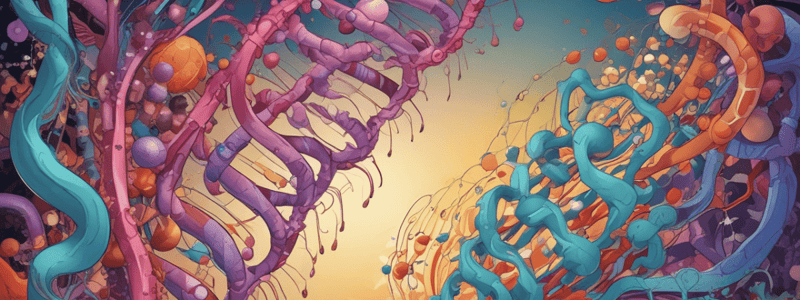Podcast
Questions and Answers
What percentage of DNA is converted into proteins?
What percentage of DNA is converted into proteins?
- 10%
- 50%
- 20%
- 5% (correct)
What happens if DNA is damaged?
What happens if DNA is damaged?
- Only proteins are affected
- Nothing happens
- Only some mRNAs are affected
- All mRNAs and proteins are affected (correct)
How many copies of DNA are present in diploid cells?
How many copies of DNA are present in diploid cells?
- 1
- 8
- 2 (correct)
- 4
What is the approximate percentage of DNA that is transcribed into RNA?
What is the approximate percentage of DNA that is transcribed into RNA?
What is the relationship between the number of molecules and the flow of genetic information?
What is the relationship between the number of molecules and the flow of genetic information?
Why is it essential to copy DNA with high fidelity?
Why is it essential to copy DNA with high fidelity?
What is the main reason why the error in RNA molecules is less important than in DNA?
What is the main reason why the error in RNA molecules is less important than in DNA?
Why is the repair of DNA more important than the repair of RNA and proteins?
Why is the repair of DNA more important than the repair of RNA and proteins?
What is the main reason why the error rate is higher in translation than in replication?
What is the main reason why the error rate is higher in translation than in replication?
Why is there a balance between the effort to maintain fidelity and the cost of energy expenditure?
Why is there a balance between the effort to maintain fidelity and the cost of energy expenditure?
What is the main function of the control mechanisms in DNA replication, transcription, and translation?
What is the main function of the control mechanisms in DNA replication, transcription, and translation?
What is the consequence of the error in protein structure compared to error in sequence?
What is the consequence of the error in protein structure compared to error in sequence?
What is the main purpose of the kinetic discrimination mechanism?
What is the main purpose of the kinetic discrimination mechanism?
What is the error rate of the kinetic discrimination mechanism?
What is the error rate of the kinetic discrimination mechanism?
What is the purpose of the proofreading mechanism?
What is the purpose of the proofreading mechanism?
Which type of DNA polymerase does not have proofreading activity?
Which type of DNA polymerase does not have proofreading activity?
What is the combined error rate of the kinetic discrimination and proofreading mechanisms?
What is the combined error rate of the kinetic discrimination and proofreading mechanisms?
What is the result of using the proofreading mechanism?
What is the result of using the proofreading mechanism?
What is the purpose of post-replicative repair mechanisms?
What is the purpose of post-replicative repair mechanisms?
What is the final fidelity of DNA replication after all mechanisms are taken into account?
What is the final fidelity of DNA replication after all mechanisms are taken into account?
Flashcards are hidden until you start studying
Study Notes
Central Dogma in Numbers
- Genetic information is presented in DNA, transcribed into RNA, and ends in proteins.
- DNA accounts for 100% of genetic information, but only about 80% is transcribed into RNA, and only about 5% of that is converted into proteins.
- The amount of genetic information decreases from DNA to metabolites, but the number of molecules increases exponentially.
- There is a single copy of DNA per cell (two if diploid), but multiple copies of RNA and proteins, with varying concentrations that can establish the phenotype of the organism.
Error Rates and Fidelity
- The error rate is lowest in replication and highest in translation, with a higher fidelity in DNA synthesis compared to mRNA or protein synthesis.
- The pressure to correct errors decreases as you move from DNA to metabolites, with repair being more important in DNA and degradation being more practical in RNA and proteins.
- The error rate in DNA replication is critical, as all subsequent mRNA and protein molecules will be affected.
Stability and Degradation
- DNA is extremely stable and does not degrade, except in apoptosis.
- mRNA and proteins are unstable and have short half-lives, making errors in these molecules transient and eventually disappearing.
- The instability of mRNA and proteins reduces the need for correction and allows for degradation of faulty molecules.
Control of Fidelity and Energy Cost
- Maintaining fidelity requires a balance between the energy expended to correct errors and the energy cost of doing so.
- The cost of maintaining fidelity includes factors such as transcriptional noise, biological noise, and the energy required to eliminate errors.
- The trade-off between fidelity and energy cost affects the speed of copying, the number of genes involved, and the overall expression of genetic information.
Mechanism of Proofreading in DNA Pol
- DNA polymerase has a high fidelity due to two mechanisms: kinetic discrimination and proofreading.
- Kinetic discrimination involves the correct pairing of nucleotides with the template, ensuring a stable bond.
- Proofreading involves a second active center that checks the correctness of the bond, requiring the DNA polymerase to have a 3'→5' exonuclease activity.
- The combination of these two mechanisms results in a very low error rate of 10^-7 to 10^-8.
- The use of proofreading reduces the error rate but slows down the process and increases the energy cost and number of genes required.
Studying That Suits You
Use AI to generate personalized quizzes and flashcards to suit your learning preferences.




